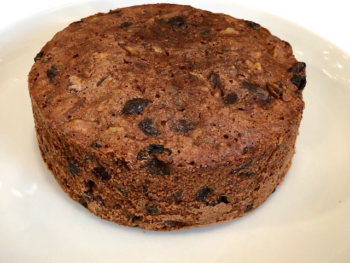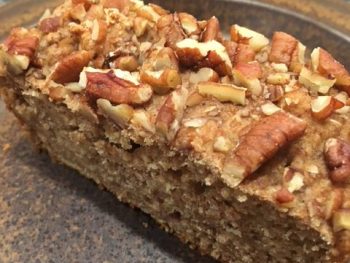Commercial flour is processed by grain mills for industrial scale baking. Nearly all flour on grocery shelves comes from those mills. While flour starts with whole grain wheat, loaded with nutrients and fibre, it ends as a starchy flour product that requires vitamins added in to meet minimum nutritional requirements.
Most of us think that flour is one of the most wholesome foods available. After all, it's made from wheat, the "staff of life". Wheat kernels are, in fact, packed with vitamins, minerals, bran, oils, antioxidants, phytochemicals, micronutrients, and much more that our bodies crave for health. All these hidden gems of nutrition work together to start processes that nourish us and help us ward off disease.
But the way commercial flour is made strips out most nutrients. Some nutrients remain, or are artificially added back in, but flour processing turns powerhouse wheat into mostly starch. This makes it impossible for typical commercial flour to match the host of benefits that whole grain flour delivers naturally.
But just try finding real flour made with the whole grain in a grocery store. It's not there. But that's no surprise. Home bakers regularly hear that whole grain flour is not useful for most baking so why would they look for it?
Obviously whole grain flour is not whole wheat, white, all-purpose, bread, self-rising, or any other highly refined flour product. Real flour is different and requires some practice to use well. But it is versatile and can produce some of the best baking you've ever had.
Read on to discover 5 big reasons that industrially processed flour might just tick you off.
Reason 1: Shelf Life Matters Much More Than Nutrition
To extend shelf life, mills strip flour of valuable oils because oils become rancid. But those oils contain antioxidants, vitamins, and lots more that our bodies need.
Some nutrients are lost to the high heat of metal roller mills that process out the best parts of whole grain flour. Others are filtered out by design.
After eliminating the most nutritious parts of the wheat kernel, which could have become whole grain flour if left alone, the resulting white flour product can sit on a shelf for ages but is little more than starch with a few vitamins and minerals artificially added. The bag may say “all purpose flour” or “enriched white flour,” but our bodies recognize that the bag primarily holds sugar in the form of starch.
Reason 2: Commercial Flour Contains Chemicals and Other Weird Stuff
Home bakers don’t need dough enhancers in flour. We don’t need bone meal, limestone, or chalk for any earthly reason, yet all are allowed in Canadian flour under "Canada Food Regulation Section B.13.001 [S] (f), Flour, White Flour, Enriched Flour or Enriched White Flour." We don’t need additives banned outside Canada over health concerns. We don’t need flour bleached unnaturally white with chlorine or peroxide just for marketing.
Toronto Star, March, 2014
To say that home bakers deserve better is an understatement. We deserve pure flour that contains all the healthfulness nature intended but what we get is flour stripped of most nutrients and altered with chemicals that aid industrial baking equipment or speed up baking to boost factory efficiency.
Reason 3: Commercial Flour Has Too Many Empty Calories
Removing 5% of a wheat kernel might not seem like much but that depends on what the 5% does. If you somehow misplaced the 2% of your body called the brain, you would really miss it. The germ of the wheat kernel is only about 2.5-3% of the kernel but is a powerful source of nutrition for the next plant that the wheat kernel seed is meant to grow. It is a nutrition superstar.
The bran, the hard, layered outer surface, is about 13-19% of the kernel and is loaded with fibre, B-vitamins, minerals, and important bioactive compounds. The endosperm represents about 80-83% of the wheat kernel and is mostly starch, some vitamins, and some protein.
No flour ad has ever said, “We strip most good stuff from whole grain flour and leave mainly starch that turns into sugar as you eat it”, but that is the empty calories truth.
Reason 4: Whole Grain Flour Fights Disease, But White Flours Can’t
THE GERM:
The germ is also packed with phytosterols, which help keep down bad cholesterol. The fatty acid linoleic acid, and others, help with endurance, reduce cholesterol, and slow aging.
When the germ is plucked from wheat, it is sold for its valuable oils and other powerful nutrients to the pharmaceutical, cosmetic, and health food industries, where its goodness suddenly becomes a big deal. Had the germ simply stayed in whole grain flour in the first place, all those wonderful benefits could have reached many of us in a morning muffin. When removing 5% of the kernel includes removing the 2.5-3% that is the germ, the loss is huge.
THE BRAN:
About 90 million tons of wheat bran are separated from wheat kernels each year, but only 10% of it is used in our foods. The other 90% mainly goes to feed livestock. Some bran is added back into some flour but others contain none. Clearly, a lot of bran is leaving flour production and going elsewhere.
By losing so much bran, we've lost the functional food power it could have added to our daily diet through bran’s numerous antioxidants, minerals, vitamins, fibre and more.

Studies show that the nutrients in bran help fight breast, prostate, and colon cancers. They battle diabetes, obesity, and cardiovascular disease. They help lower cholesterol and reduce inflammation.
The many nutrients in bran work together. A study focused on cancer put it this way:
The bran needs all its ingredients in the amounts that nature so carefully calculated to deliver all its healthfulness.
Clearly, if much of the germ and bran are removed from commercial flour, they can't deliver health benefits.
Reason 5: White Flour is Mostly Starch, and Starch Turns Into Sugar, So White Flour is Mostly…
The endosperm is the starchy interior that makes up about 80-83% of the wheat kernel. Despite its size, it contains few vitamins and minerals compared to the germ and bran. It is mostly starch, which is a carb. Like any carb, starch turns into sugar once consumed. And we all know that sugar gives a temporary burst of sugar energy.
The budding wheat plant uses its sugar energy to start growing. It also uses the protein and small amounts of minerals and vitamins in the endosperm, but further growth has to come from nutrients outside the endosperm.
“From a health perspective, the entire operation may seem ass backward: the bran and germ should stay while the endosperm gets discarded.”
Stephen Yafa, author, Grain of Truth
Starch from the endosperm is most of what is found in a bag of industrially milled flour. There might be some bran added back in. There might be a dash of the germ. But even with “enrichment” commercial flour lacks the innate ability to be as healthful as real, whole grain flour.
The Bottom Line
Industrially-milled flour, like standard white or all-purpose, contains only about a third of B vitamins and minerals, and only about 21% of the fibre originally found in a wheat kernel. Perhaps even worse is that the critical interaction of all three parts of the wheat kernel is destroyed. No clumsy, incomplete “enrichment” can ever duplicate what nature had originally created within each kernel.
While the original wheat kernel is a nutritional powerhouse, all its parts need to be in flour in their original proportions to harmoniously work as nature intended. Commercial flour production destroys the balance and the beneficial potential.
A wheat kernel is a seed. And like any seed, it’s a little machine whose parts work together to sprout a new plant. Nutrients and chemical processes jump into action. We need those same nutrients and chemical processes to sustain us.
What To Do Next?
Some independent mills offer whole grain flour. Too many, however, do not specify the specific wheat variety or blends they offer. Your choices tend to be flour types (bread flour versus all-purpose, for example). And obviously, without your own mill, you are limited to whatever grind you get.
The ability to mill from very course to very fine allows you to do so much more with whole grains. From milling very finely textured whole grain pastry flour to extra-chunky grains for beer brewing, whole grains can naturally find their way into many meals. And, of course, you can mill gluten free cereals, pulses, spices, rice, and more.
Did you know that many properly stored grains can have a shelf life of years? Each time you mill whole grains, you create truly fresh flour. Mill small batches as needed to maximize healthfulness.
And be sure to have fun as you explore making whole grains and whole grain flour your delicious and unique new ingredients.
OUR FRIENDS AT MOCKMILL
Good Granary is so pleased that Germany's Mockmill Stone Grain Mills have joined us in Canada. We like to say that a Mockmill is the new kitchen essential and we mean it! Not only is flour milled with a Mockmill the freshest possible, but you always know it's pure. Plus, for most of us, it's a new adventure in baking.
Check out out Shop



